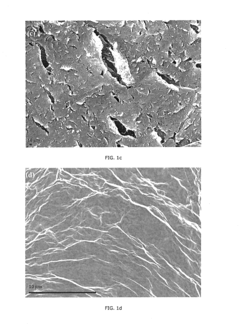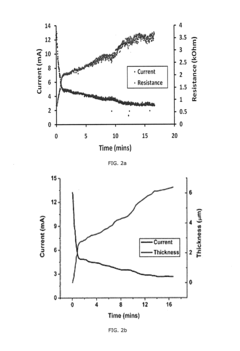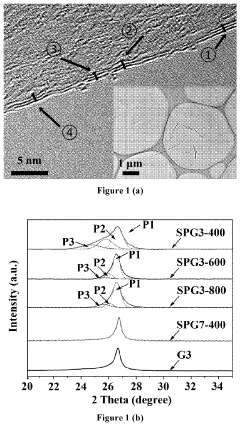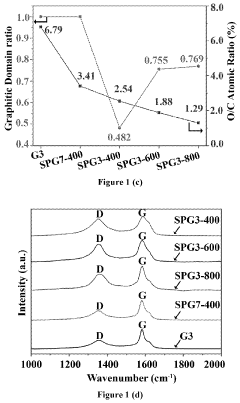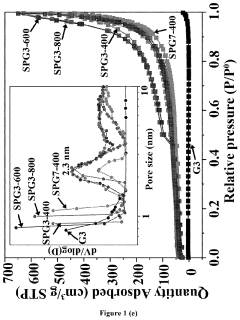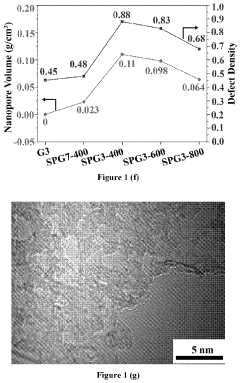How to Accelerate Graphene Battery Market Adoption?
AUG 6, 202510 MIN READ
Generate Your Research Report Instantly with AI Agent
Patsnap Eureka helps you evaluate technical feasibility & market potential.
Graphene Battery Evolution and Objectives
Graphene batteries represent a revolutionary advancement in energy storage technology, promising to overcome many limitations of traditional lithium-ion batteries. The evolution of graphene batteries can be traced back to the discovery of graphene in 2004, which sparked intense research into its potential applications. Since then, significant progress has been made in harnessing graphene's unique properties for battery technology.
The primary objective of graphene battery development is to create a high-performance energy storage solution that offers superior capacity, faster charging times, and longer lifespan compared to conventional batteries. Researchers aim to leverage graphene's exceptional electrical conductivity, mechanical strength, and large surface area to enhance battery performance across various metrics.
One of the key evolutionary milestones in graphene battery technology has been the development of graphene-enhanced electrodes. By incorporating graphene into battery electrodes, scientists have successfully increased the surface area for ion transfer, leading to improved energy density and faster charging capabilities. This advancement has paved the way for batteries that can potentially charge in minutes rather than hours.
Another significant objective in the field is to improve the overall stability and safety of batteries. Graphene's thermal conductivity and mechanical strength contribute to better heat dissipation and structural integrity, addressing common issues such as thermal runaway and physical degradation that plague traditional lithium-ion batteries.
The evolution of graphene batteries also encompasses the exploration of various graphene forms and composites. Researchers are investigating the use of graphene oxide, reduced graphene oxide, and graphene nanoplatelets, each offering unique advantages in battery design. The goal is to optimize the balance between performance enhancement and cost-effectiveness to make graphene batteries commercially viable.
As the technology progresses, a crucial objective is to scale up production processes for graphene-based battery components. This involves developing efficient and cost-effective methods for large-scale graphene synthesis and integration into battery manufacturing. Achieving this goal is essential for transitioning graphene batteries from laboratory prototypes to mass-produced consumer products.
The ultimate aim of graphene battery evolution is to revolutionize energy storage across various sectors, including consumer electronics, electric vehicles, and grid-scale energy storage. By addressing the limitations of current battery technologies, graphene batteries have the potential to accelerate the adoption of electric vehicles, enhance the performance of portable devices, and improve the efficiency of renewable energy systems.
The primary objective of graphene battery development is to create a high-performance energy storage solution that offers superior capacity, faster charging times, and longer lifespan compared to conventional batteries. Researchers aim to leverage graphene's exceptional electrical conductivity, mechanical strength, and large surface area to enhance battery performance across various metrics.
One of the key evolutionary milestones in graphene battery technology has been the development of graphene-enhanced electrodes. By incorporating graphene into battery electrodes, scientists have successfully increased the surface area for ion transfer, leading to improved energy density and faster charging capabilities. This advancement has paved the way for batteries that can potentially charge in minutes rather than hours.
Another significant objective in the field is to improve the overall stability and safety of batteries. Graphene's thermal conductivity and mechanical strength contribute to better heat dissipation and structural integrity, addressing common issues such as thermal runaway and physical degradation that plague traditional lithium-ion batteries.
The evolution of graphene batteries also encompasses the exploration of various graphene forms and composites. Researchers are investigating the use of graphene oxide, reduced graphene oxide, and graphene nanoplatelets, each offering unique advantages in battery design. The goal is to optimize the balance between performance enhancement and cost-effectiveness to make graphene batteries commercially viable.
As the technology progresses, a crucial objective is to scale up production processes for graphene-based battery components. This involves developing efficient and cost-effective methods for large-scale graphene synthesis and integration into battery manufacturing. Achieving this goal is essential for transitioning graphene batteries from laboratory prototypes to mass-produced consumer products.
The ultimate aim of graphene battery evolution is to revolutionize energy storage across various sectors, including consumer electronics, electric vehicles, and grid-scale energy storage. By addressing the limitations of current battery technologies, graphene batteries have the potential to accelerate the adoption of electric vehicles, enhance the performance of portable devices, and improve the efficiency of renewable energy systems.
Market Demand Analysis for Advanced Energy Storage
The market demand for advanced energy storage solutions, particularly graphene batteries, is experiencing significant growth driven by the increasing need for high-performance, sustainable power sources across various industries. The global energy storage market is projected to reach substantial value in the coming years, with graphene batteries poised to capture a significant share due to their superior properties.
In the automotive sector, the shift towards electric vehicles (EVs) is creating a robust demand for advanced battery technologies. Graphene batteries offer potential advantages such as faster charging times, increased energy density, and improved longevity compared to traditional lithium-ion batteries. This aligns well with consumer expectations for longer-range EVs and reduced charging times, addressing key barriers to EV adoption.
The consumer electronics industry is another major driver for graphene battery adoption. With the proliferation of smartphones, tablets, and wearable devices, there is a growing demand for batteries that can provide longer usage times while maintaining compact form factors. Graphene batteries' potential for higher energy density and faster charging capabilities make them an attractive option for device manufacturers looking to differentiate their products in a competitive market.
Renewable energy integration presents another significant market opportunity for graphene batteries. As wind and solar power generation increases, the need for efficient and scalable energy storage solutions becomes critical. Graphene batteries could play a crucial role in grid stabilization and energy management, offering improved performance and longer cycle life compared to current storage technologies.
The industrial and aerospace sectors are also showing interest in graphene battery technology. In industrial applications, the demand for high-power, fast-charging batteries for electric forklifts, automated guided vehicles, and other equipment is growing. The aerospace industry is exploring graphene batteries for their potential to reduce weight and increase energy density in aircraft and satellite systems.
However, the market demand is tempered by several factors. The higher cost of graphene batteries compared to established technologies remains a significant barrier to widespread adoption. Additionally, concerns about the scalability of graphene production and the need for further research and development to fully realize the technology's potential are influencing market dynamics.
Despite these challenges, the overall market trajectory for graphene batteries is positive. As research progresses and manufacturing processes improve, the cost-performance ratio is expected to become more favorable, potentially accelerating market adoption across various sectors. The growing emphasis on sustainability and energy efficiency in global markets further supports the long-term demand for advanced energy storage solutions like graphene batteries.
In the automotive sector, the shift towards electric vehicles (EVs) is creating a robust demand for advanced battery technologies. Graphene batteries offer potential advantages such as faster charging times, increased energy density, and improved longevity compared to traditional lithium-ion batteries. This aligns well with consumer expectations for longer-range EVs and reduced charging times, addressing key barriers to EV adoption.
The consumer electronics industry is another major driver for graphene battery adoption. With the proliferation of smartphones, tablets, and wearable devices, there is a growing demand for batteries that can provide longer usage times while maintaining compact form factors. Graphene batteries' potential for higher energy density and faster charging capabilities make them an attractive option for device manufacturers looking to differentiate their products in a competitive market.
Renewable energy integration presents another significant market opportunity for graphene batteries. As wind and solar power generation increases, the need for efficient and scalable energy storage solutions becomes critical. Graphene batteries could play a crucial role in grid stabilization and energy management, offering improved performance and longer cycle life compared to current storage technologies.
The industrial and aerospace sectors are also showing interest in graphene battery technology. In industrial applications, the demand for high-power, fast-charging batteries for electric forklifts, automated guided vehicles, and other equipment is growing. The aerospace industry is exploring graphene batteries for their potential to reduce weight and increase energy density in aircraft and satellite systems.
However, the market demand is tempered by several factors. The higher cost of graphene batteries compared to established technologies remains a significant barrier to widespread adoption. Additionally, concerns about the scalability of graphene production and the need for further research and development to fully realize the technology's potential are influencing market dynamics.
Despite these challenges, the overall market trajectory for graphene batteries is positive. As research progresses and manufacturing processes improve, the cost-performance ratio is expected to become more favorable, potentially accelerating market adoption across various sectors. The growing emphasis on sustainability and energy efficiency in global markets further supports the long-term demand for advanced energy storage solutions like graphene batteries.
Current Challenges in Graphene Battery Development
Despite the promising potential of graphene batteries, several significant challenges currently hinder their widespread adoption in the market. One of the primary obstacles is the high production cost associated with graphene synthesis and battery manufacturing processes. The complex and energy-intensive methods required to produce high-quality graphene materials contribute to elevated expenses, making graphene batteries less competitive compared to traditional lithium-ion batteries.
Another critical challenge lies in scaling up production to meet commercial demands. While laboratory-scale demonstrations have shown impressive results, translating these achievements into large-scale manufacturing processes remains a formidable task. Ensuring consistent quality and performance across mass-produced graphene batteries poses significant technical hurdles that need to be overcome.
The long-term stability and cycle life of graphene batteries also present concerns. Although graphene exhibits excellent theoretical properties, maintaining these characteristics over extended periods and numerous charge-discharge cycles in real-world applications is challenging. Issues such as capacity fading and structural degradation of graphene-based electrodes need to be addressed to ensure the longevity and reliability of graphene batteries.
Furthermore, the integration of graphene batteries into existing electronic devices and energy storage systems poses compatibility challenges. Adapting current manufacturing processes and infrastructure to accommodate graphene battery technology requires substantial investments and modifications, which may deter some manufacturers from adopting this new technology.
Safety concerns also play a crucial role in the development and adoption of graphene batteries. While graphene itself is generally considered safe, the combination of graphene with other battery components and electrolytes may introduce new safety risks that need to be thoroughly evaluated and mitigated before widespread commercialization can occur.
Regulatory hurdles and standardization issues further complicate the path to market adoption. The lack of established industry standards and regulatory frameworks specific to graphene batteries creates uncertainty for manufacturers and potential users. Developing and implementing appropriate safety and performance standards is essential to build trust and facilitate market acceptance.
Lastly, the competition from rapidly advancing alternative battery technologies, such as solid-state batteries and other next-generation energy storage solutions, poses a significant challenge to graphene battery adoption. As these competing technologies continue to progress, graphene batteries must demonstrate clear advantages in performance, cost, and reliability to secure a significant market share.
Another critical challenge lies in scaling up production to meet commercial demands. While laboratory-scale demonstrations have shown impressive results, translating these achievements into large-scale manufacturing processes remains a formidable task. Ensuring consistent quality and performance across mass-produced graphene batteries poses significant technical hurdles that need to be overcome.
The long-term stability and cycle life of graphene batteries also present concerns. Although graphene exhibits excellent theoretical properties, maintaining these characteristics over extended periods and numerous charge-discharge cycles in real-world applications is challenging. Issues such as capacity fading and structural degradation of graphene-based electrodes need to be addressed to ensure the longevity and reliability of graphene batteries.
Furthermore, the integration of graphene batteries into existing electronic devices and energy storage systems poses compatibility challenges. Adapting current manufacturing processes and infrastructure to accommodate graphene battery technology requires substantial investments and modifications, which may deter some manufacturers from adopting this new technology.
Safety concerns also play a crucial role in the development and adoption of graphene batteries. While graphene itself is generally considered safe, the combination of graphene with other battery components and electrolytes may introduce new safety risks that need to be thoroughly evaluated and mitigated before widespread commercialization can occur.
Regulatory hurdles and standardization issues further complicate the path to market adoption. The lack of established industry standards and regulatory frameworks specific to graphene batteries creates uncertainty for manufacturers and potential users. Developing and implementing appropriate safety and performance standards is essential to build trust and facilitate market acceptance.
Lastly, the competition from rapidly advancing alternative battery technologies, such as solid-state batteries and other next-generation energy storage solutions, poses a significant challenge to graphene battery adoption. As these competing technologies continue to progress, graphene batteries must demonstrate clear advantages in performance, cost, and reliability to secure a significant market share.
Existing Graphene Battery Solutions
01 Improved energy storage capacity
Graphene batteries offer significantly higher energy storage capacity compared to traditional lithium-ion batteries. This increased capacity allows for longer-lasting devices and potentially smaller battery sizes, making them attractive for various applications including consumer electronics and electric vehicles.- Improved energy storage capacity: Graphene batteries offer significantly higher energy storage capacity compared to traditional lithium-ion batteries. This improvement is due to graphene's unique properties, including high surface area and excellent conductivity. The increased energy density makes graphene batteries attractive for various applications, particularly in portable electronics and electric vehicles.
- Enhanced charging speed and cycle life: Graphene-based batteries demonstrate faster charging capabilities and longer cycle life compared to conventional batteries. The rapid electron transfer in graphene allows for quick charging, while its structural stability contributes to improved durability. These features address key consumer demands in the battery market, potentially accelerating adoption across various industries.
- Integration with renewable energy systems: Graphene batteries show promise for integration with renewable energy systems, such as solar and wind power. Their high energy density and fast charging capabilities make them suitable for storing and distributing intermittent renewable energy. This application could drive market adoption in the growing sustainable energy sector.
- Advancements in manufacturing processes: Ongoing research and development in graphene battery manufacturing processes are addressing scalability and cost issues. Improved production techniques aim to reduce manufacturing costs and increase production efficiency, making graphene batteries more competitive in the market. These advancements are crucial for widespread commercial adoption.
- Applications in emerging technologies: Graphene batteries are finding applications in emerging technologies such as wearable devices, Internet of Things (IoT) sensors, and advanced medical devices. The unique properties of graphene, including flexibility and lightweight nature, make these batteries suitable for integration into innovative products, potentially driving market adoption in new sectors.
02 Enhanced charging speed
Graphene-based batteries demonstrate faster charging capabilities, reducing the time required to reach full capacity. This feature is particularly appealing for electric vehicles and portable devices, where quick charging is a significant advantage for market adoption.Expand Specific Solutions03 Improved thermal management
Graphene's excellent thermal conductivity properties contribute to better heat dissipation in batteries. This leads to improved safety, reduced risk of overheating, and potentially longer battery life, addressing key concerns in battery technology adoption.Expand Specific Solutions04 Integration with flexible electronics
Graphene's flexibility and strength make it suitable for developing flexible and wearable battery technologies. This opens up new possibilities for market adoption in emerging fields such as wearable devices, smart textiles, and flexible displays.Expand Specific Solutions05 Environmental sustainability
Graphene batteries offer potential environmental benefits compared to traditional battery technologies. They may require fewer rare earth materials, have a longer lifespan, and potentially be more recyclable. These factors could drive market adoption as sustainability becomes increasingly important to consumers and regulators.Expand Specific Solutions
Key Players in Graphene Battery Industry
The graphene battery market is in its early growth stage, characterized by increasing research and development efforts from both academic institutions and commercial entities. The market size is expanding, driven by the potential for high-performance energy storage solutions. While the technology shows promise, its maturity level varies across different applications. Key players like Northwestern University, Zhejiang University, and Rensselaer Polytechnic Institute are leading academic research, while companies such as Honeycomb Battery Co. and Global Graphene Group are pushing for commercialization. The involvement of established corporations like IBM and NEC Corp. indicates growing industry interest, suggesting a competitive landscape poised for significant advancements in the coming years.
Northwestern University
Technical Solution: Northwestern University has developed a graphene-based electrode material for lithium-ion batteries that demonstrates superior performance. Their approach involves creating a three-dimensional graphene scaffold with high porosity and surface area, which allows for improved lithium storage capacity and faster charge/discharge rates[1]. The university's research team has also explored the use of graphene oxide as a coating for conventional electrode materials, enhancing their stability and conductivity[2]. Additionally, they have investigated the potential of graphene-based supercapacitors for energy storage applications, which could complement battery technology in certain use cases[3].
Strengths: Cutting-edge research in graphene-based energy storage, potential for high-performance batteries. Weaknesses: As an academic institution, may face challenges in commercialization and large-scale production.
Honeycomb Battery Co.
Technical Solution: Honeycomb Battery Co. has developed a proprietary graphene-enhanced battery technology that significantly improves energy density and charging speed. Their approach involves incorporating graphene into a unique honeycomb structure within the battery cells, which increases the surface area for electron transfer and enhances overall battery performance[4]. The company claims their batteries can achieve up to 50% higher energy density compared to conventional lithium-ion batteries, while also reducing charging times by up to 70%[5]. Honeycomb Battery Co. is actively working on scaling up production and has partnered with several automotive manufacturers for potential integration into electric vehicles.
Strengths: Innovative graphene-based battery design, promising performance improvements. Weaknesses: Relatively new company, may face challenges in large-scale manufacturing and market penetration.
Breakthrough Innovations in Graphene Battery Tech
Rapid macro-scale synthesis of free-standing graphene, high performance, binder-free graphene anode material, and methods of synthesizing the anode material
PatentInactiveUS20140050910A1
Innovation
- A method involving the combination of graphite oxide with water to form a colloidal suspension, applying a potentiostatic field, and drying to create a graphene oxide paper, followed by photo-thermal or thermal exfoliation to produce reduced graphene oxide (RGO) paper with high thickness and surface area, enabling scalable and efficient production.
Graphene processing technique
PatentPendingUS20240021820A1
Innovation
- A surfactant-assisted thermal reductive perforation process using poly(alkylene oxide) to generate surface-perforated graphene with in-plane mesopores, expanded interlayer lattice, and low oxygen content, facilitating AlCl4− ion storage by weakening interlayer interactions and creating accessible sites.
Regulatory Framework for New Battery Technologies
The regulatory framework for new battery technologies plays a crucial role in accelerating the adoption of graphene batteries in the market. As graphene batteries represent a novel and potentially disruptive technology, it is essential to establish a comprehensive and adaptive regulatory environment that ensures safety, performance, and environmental sustainability while fostering innovation and market growth.
Current battery regulations primarily focus on traditional lithium-ion technologies, which may not fully address the unique characteristics and potential risks associated with graphene batteries. To facilitate market adoption, regulatory bodies must develop specific guidelines and standards for graphene battery manufacturing, testing, and disposal. These regulations should encompass safety protocols, performance benchmarks, and environmental impact assessments tailored to the properties of graphene-based energy storage systems.
One key aspect of the regulatory framework should be the establishment of standardized testing procedures for graphene batteries. These tests should evaluate factors such as energy density, charge/discharge rates, cycle life, and thermal stability under various operating conditions. By implementing consistent testing methodologies, regulators can ensure that graphene batteries meet or exceed the performance and safety standards of existing technologies, thereby building consumer confidence and facilitating market acceptance.
Environmental regulations will also play a significant role in shaping the graphene battery market. As sustainability becomes increasingly important in the energy sector, regulators must develop guidelines for the responsible sourcing of graphene materials, as well as protocols for the recycling and disposal of graphene batteries at the end of their lifecycle. These regulations should aim to minimize the environmental footprint of graphene battery production and usage while promoting circular economy principles.
To accelerate market adoption, regulatory bodies should consider implementing incentive programs and supportive policies for graphene battery development and commercialization. This could include tax credits for manufacturers, research grants for academic institutions, and subsidies for early adopters of graphene battery technology. Such measures can help offset the initial costs associated with bringing a new technology to market and encourage investment in the graphene battery sector.
International collaboration and harmonization of regulations will be crucial for the global adoption of graphene batteries. Regulatory bodies from different countries should work together to develop consistent standards and certification processes, facilitating cross-border trade and reducing barriers to market entry. This collaborative approach can help create a more unified global market for graphene batteries, accelerating their adoption across various industries and applications.
As the technology evolves, regulatory frameworks must remain flexible and adaptable to accommodate new developments in graphene battery technology. Regular reviews and updates of regulations will be necessary to ensure that they remain relevant and effective in addressing emerging challenges and opportunities in the field. This dynamic approach to regulation can help strike a balance between ensuring safety and reliability while fostering innovation and market growth in the graphene battery sector.
Current battery regulations primarily focus on traditional lithium-ion technologies, which may not fully address the unique characteristics and potential risks associated with graphene batteries. To facilitate market adoption, regulatory bodies must develop specific guidelines and standards for graphene battery manufacturing, testing, and disposal. These regulations should encompass safety protocols, performance benchmarks, and environmental impact assessments tailored to the properties of graphene-based energy storage systems.
One key aspect of the regulatory framework should be the establishment of standardized testing procedures for graphene batteries. These tests should evaluate factors such as energy density, charge/discharge rates, cycle life, and thermal stability under various operating conditions. By implementing consistent testing methodologies, regulators can ensure that graphene batteries meet or exceed the performance and safety standards of existing technologies, thereby building consumer confidence and facilitating market acceptance.
Environmental regulations will also play a significant role in shaping the graphene battery market. As sustainability becomes increasingly important in the energy sector, regulators must develop guidelines for the responsible sourcing of graphene materials, as well as protocols for the recycling and disposal of graphene batteries at the end of their lifecycle. These regulations should aim to minimize the environmental footprint of graphene battery production and usage while promoting circular economy principles.
To accelerate market adoption, regulatory bodies should consider implementing incentive programs and supportive policies for graphene battery development and commercialization. This could include tax credits for manufacturers, research grants for academic institutions, and subsidies for early adopters of graphene battery technology. Such measures can help offset the initial costs associated with bringing a new technology to market and encourage investment in the graphene battery sector.
International collaboration and harmonization of regulations will be crucial for the global adoption of graphene batteries. Regulatory bodies from different countries should work together to develop consistent standards and certification processes, facilitating cross-border trade and reducing barriers to market entry. This collaborative approach can help create a more unified global market for graphene batteries, accelerating their adoption across various industries and applications.
As the technology evolves, regulatory frameworks must remain flexible and adaptable to accommodate new developments in graphene battery technology. Regular reviews and updates of regulations will be necessary to ensure that they remain relevant and effective in addressing emerging challenges and opportunities in the field. This dynamic approach to regulation can help strike a balance between ensuring safety and reliability while fostering innovation and market growth in the graphene battery sector.
Environmental Impact of Graphene Battery Production
The environmental impact of graphene battery production is a critical consideration in the pursuit of accelerating market adoption. Graphene, a revolutionary material with exceptional properties, offers significant potential for enhancing battery performance. However, its production process raises important environmental concerns that must be addressed to ensure sustainable development and widespread acceptance.
The synthesis of graphene typically involves energy-intensive processes, such as chemical vapor deposition or exfoliation of graphite. These methods often require high temperatures and pressures, resulting in substantial energy consumption and associated greenhouse gas emissions. Additionally, the use of chemical solvents and reagents in certain production techniques can lead to the generation of hazardous waste, posing potential risks to ecosystems and human health if not properly managed.
Water usage is another environmental factor to consider in graphene battery production. Some manufacturing processes require significant amounts of water for cooling, cleaning, and purification steps. This can strain local water resources, particularly in water-scarce regions, and may lead to increased wastewater generation that requires treatment before release into the environment.
The sourcing of raw materials for graphene production, primarily high-quality graphite, also has environmental implications. Mining activities can result in habitat destruction, soil erosion, and water pollution if not conducted responsibly. Furthermore, the transportation of raw materials and finished products contributes to the overall carbon footprint of graphene battery production.
However, it is important to note that the environmental impact of graphene battery production should be evaluated in comparison to conventional battery technologies. Graphene batteries have the potential to offer higher energy density, faster charging capabilities, and longer lifespans than traditional lithium-ion batteries. These advantages could lead to reduced material consumption and waste generation over the battery's lifecycle, potentially offsetting some of the environmental costs associated with production.
To mitigate the environmental impact and accelerate market adoption, several strategies can be implemented. Investing in research and development of more environmentally friendly graphene synthesis methods, such as green chemistry approaches or bio-based production techniques, could significantly reduce the ecological footprint of manufacturing processes. Additionally, implementing closed-loop production systems and waste recovery technologies can minimize resource consumption and waste generation.
Adopting renewable energy sources for powering production facilities and optimizing energy efficiency in manufacturing processes are crucial steps towards reducing the carbon footprint of graphene battery production. Furthermore, establishing robust recycling and end-of-life management systems for graphene batteries can help recover valuable materials and minimize environmental impact throughout the product lifecycle.
The synthesis of graphene typically involves energy-intensive processes, such as chemical vapor deposition or exfoliation of graphite. These methods often require high temperatures and pressures, resulting in substantial energy consumption and associated greenhouse gas emissions. Additionally, the use of chemical solvents and reagents in certain production techniques can lead to the generation of hazardous waste, posing potential risks to ecosystems and human health if not properly managed.
Water usage is another environmental factor to consider in graphene battery production. Some manufacturing processes require significant amounts of water for cooling, cleaning, and purification steps. This can strain local water resources, particularly in water-scarce regions, and may lead to increased wastewater generation that requires treatment before release into the environment.
The sourcing of raw materials for graphene production, primarily high-quality graphite, also has environmental implications. Mining activities can result in habitat destruction, soil erosion, and water pollution if not conducted responsibly. Furthermore, the transportation of raw materials and finished products contributes to the overall carbon footprint of graphene battery production.
However, it is important to note that the environmental impact of graphene battery production should be evaluated in comparison to conventional battery technologies. Graphene batteries have the potential to offer higher energy density, faster charging capabilities, and longer lifespans than traditional lithium-ion batteries. These advantages could lead to reduced material consumption and waste generation over the battery's lifecycle, potentially offsetting some of the environmental costs associated with production.
To mitigate the environmental impact and accelerate market adoption, several strategies can be implemented. Investing in research and development of more environmentally friendly graphene synthesis methods, such as green chemistry approaches or bio-based production techniques, could significantly reduce the ecological footprint of manufacturing processes. Additionally, implementing closed-loop production systems and waste recovery technologies can minimize resource consumption and waste generation.
Adopting renewable energy sources for powering production facilities and optimizing energy efficiency in manufacturing processes are crucial steps towards reducing the carbon footprint of graphene battery production. Furthermore, establishing robust recycling and end-of-life management systems for graphene batteries can help recover valuable materials and minimize environmental impact throughout the product lifecycle.
Unlock deeper insights with Patsnap Eureka Quick Research — get a full tech report to explore trends and direct your research. Try now!
Generate Your Research Report Instantly with AI Agent
Supercharge your innovation with Patsnap Eureka AI Agent Platform!


